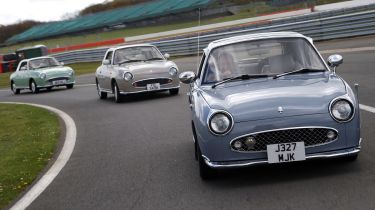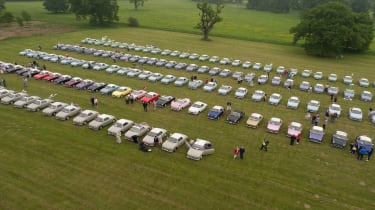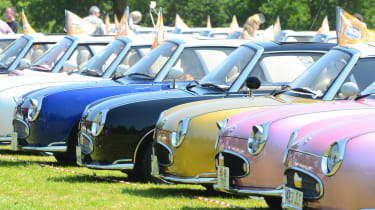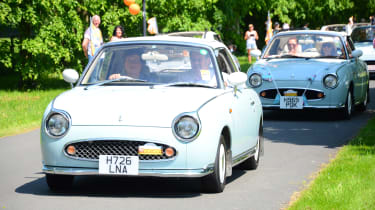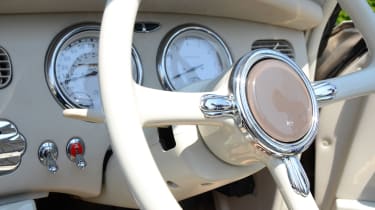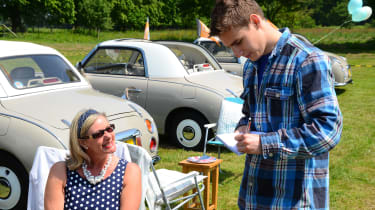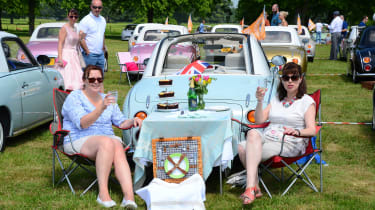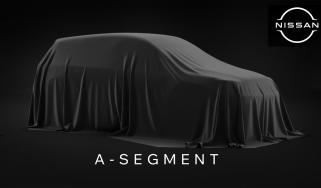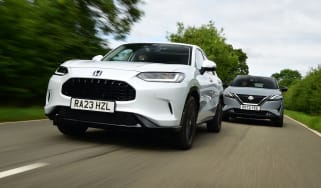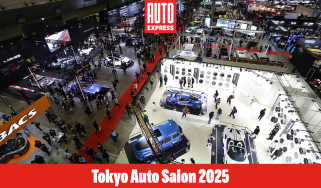Cult classic: celebrating 25 years of the Nissan Figaro
We meet the dedicated owners commemorating 25 years of Nissan's retro-styled Figaro roadster
It's an odd looking car, the Nissan Figaro. The round lamps, curvy lines and folding roof ensure it resembles a fifties roadster, something you might think MG had a role in developing. Climb inside, and the horizontal switchgear and striped leather seats have a hint of sixties Pontiac Bonneville, but below the switches sits a nineties CD player and controls for the air-conditioning.
Under the bonnet rests a turbocharged 1.0-litre four-cylinder petrol engine, a set-up you’d find in a modern supermini, but look closer and you’ll see it’s connected to a three-speed automatic. It’s a car of contradictions, and one that turns heads. Yet despite having its wheels in a whole host of decades, the Figaro is a product of the nineties – the retro roadster was built by Nissan in 1991.
To find out more about this quirky little car, Auto Express joined the 25th birthday celebrations at the Nissan Figaro Owners Club meeting at the Wroxall Abbey estate, Warks.
“The Figaro started its life as a design exercise from Nissan,” explains club founder Kevin Fagan. Nissan showcased the retro 2+2 convertible at the 1989 Tokyo Motor Show under the banner Back to the Future, and against a backdrop of overwhelming customer demand, it decided to build it. “Just 20,000 Figaros were made, but demand for them was so high, Nissan had to create a lottery with 100,000 tickets to satisfy potential owners,” Fagan tells us. The 20,000 lucky owners had a choice of four colours, representing the four seasons in Japan. The rarest is the Topaz Mist (autumn); just 2,000 cars were finished in this colour. There were 6,000 examples each in Lapis Grey (winter), Emerald Green (spring), and Pale Aqua (summer).
According to Fagan, there are around 4,500 Figaros in the UK; most are grey imports as the model was never officially sold here. “The cars range in price from around £2,000 to over £20,000,” he explains.
The biggest selling point the Figaro has is the way it combines retro looks and appeal with modern mechanics and reliability. “The car is based on the Nissan Micra,” adds Fagan. “It uses the same 1.0-litre four-cylinder engine as the Micra, and is mated to a three-speed automatic. It’s a bulletproof car.” Many owners share the same opinion. India Christie, from Stalybridge, Manchester, told Auto Express: “I had a green VW Beetle before this, along with an old Mini, but both kept breaking down. Because the Figaro has a modern engine and transmission, I never have trouble with it. I’m able to use it as a daily driver.”
Reliability is a characteristic long associated with the Nissan brand, yet this car doesn’t wear the badge. Only the tiniest Nissan inscription can be seen above the fleur-de-lys Figaro badges. Fagan says the car was very different from other cars built by the company at the time, and to this day most people don’t recognise it as a Nissan.
To celebrate this unique model, 275 owners have travelled to the Wroxall Abbey estate which is alive with the raspy rumbling of those 1.0-litre engines with proud owners parking up their cars in colour-coded rows.
Although the car was built in 1991, owners are fully embracing the fifties and sixties look the Figaro tries to emulate, with women wearing vintage dresses and the men donning colourful blazers with spotted bowties.
There are judges circling around, rating the cars for the awards ceremony that’s set to be held at the end of the day. Tony Darwent, a judge for the Owners Club, tells us: “With any classic car, originality is key. A lot of the cars here don’t have the nose wand, for example.” This is a metal rod sticking upwards from the front bumper, allowing drivers to estimate where the front end of the 3.7-metre-long car is when parking.
The nose wand is just one of the tiny details that has people peeking around the cars. The stylish leather seats have a coloured stripe running along them, matching the exterior colour, while the dials are in kilometres rather than miles. The windows may be electric, but the roof folds down by hand, and the indicator stalk is on the right-hand side of the steering wheel, not the left.
Owners love these tiny details; many could be found buffing their cars up to a shine as we pass by. The Owners Club regularly organises trips for owners to take their cars to other countries and show them off. Places already ticked off the list include the Netherlands, and Normandy; this year there will be a trip to Belgium.
A day spent with the owners has left us considering how we’d go about buying one of these characterful little roadsters. So we speak to Anthony Absolom, final build mechanic at the Figaro Shop, a garage in Didcot, Oxon, that specialises in Figaro repairs and rebuilds. Anthony has some essential advice for us and anyone else thinking of taking the plunge. “The car is mechanically very good, the engine and gearbox are often trouble-free, but being in Britain, a lot of the cars suffer from rust,” he says.
“Because a lot of the bodywork is unique to the Figaro, dents and scuffs can often be expensive to repair or replace, so look out for both of these things on top of your normal mechanical checks.”
Even so, having spoken to many owners, you might struggle to find a Figaro for sale; once you’ve bought one, it seems you’re unlikely to sell it. We wonder how many other nineties cars you can say that about...
What’s it like to drive?
Throughout the day, owners praise the car for its smooth driving. We climb aboard a yellow Figaro belonging to Jane Ellison-Bates, of Grassington, North Yorkshire (the paint was an aftermarket job), to try it out.
Even though the 1.0-litre engine is a bit short on capacity, it’s raspy and throaty, gurgling potently as we apply small amounts of throttle. The thin, wide plastic steering wheel feels odd at first, but you soon familiarise yourself with its dimensions. Push the throttle and the three-speed automatic gearbox is slow to change, although the shift is smooth. The suspension feels stiff and old-fashioned, yet thanks to the comfortable seats, the ride is very supple.
The Figaro isn’t a driver’s car, but the wide steering wheel and tiny engine make it sound and feel like an old classic. It’s even more pleasing to drive knowing you’re unlikely to encounter any of the mechanical issues that often blight classic ownership.
Loraine Horne
Witney, Oxfordshire
“With young daughters growing up, I had to wait for years before I could buy one. I love the way it looks and drives. I use it every day and have put 18,000 miles on it in the past 18 months. If I could, I’d buy more so I could have them in all the different colours.”
Gill Burns
Warrington, Cheshire
“I bought the car last April. I saw one driving round and decided I needed to have one. It’s more of a weekend car for me, but still gets plenty of use. There’s talk about the trip to Belgium taking place, so perhaps my husband and I will have to go for it.”
Tony Darwent
Bakewell, Derbyshire
“I once drove an Austin Healey alongside the Figaro, and amazingly the Figaro got more questions and waves than the Austin did. It’s such an appealing car; it looks friendly and people just seem to be drawn to it.”
Sara Reilly
Leamington Spa, Warwickshire
“When I saw the car I instantly fell in love. It drives smoothly, although I try to avoid the motorways. It’s such a good looking car, and although mine has done nearly 100,000 miles, I don’t see myself selling it any time soon.”
Find a car with the experts
